The journey into Rongxian was far more quick and relaxed than I had previously remembered. After sleeping in the airport after my flight landed in Guangzhou, I joined up with my mother and youngest brother Tony and departed for the subway station at 6 in the morning and headed to the bus station.
Once there, I marveled at the construction of two massive apartment towers just outside the bus station. No surprises there — Guangzhou is a big city, one expects it to grow and grow at a rapid clip.
We boarded the first bus to Rongxian at 8 in the morning and headed west. I’m pretty sure that the bus driver and the hostess were the same husband and wife duo that we had ridden with for years and years before. We stopped by the same rest area that we’ve been stopping by for the past twenty years, a rest stop that has had only one remodel that I remember.
Rest stop over, we boarded the bus and continued driving west. And then, we were home: the city of Rongxian, a mere six hours after we had left the city of Guangzhou. For some reason, that seemed really fast to me. Did the roads get a lot better, allowing us to make better time? Or did it always take this long and I had somehow not noticed it this time around?
One thing I did notice immediately was that the once in-the-middle-of-nowhere South Bus Station was now no longer in the middle of nowhere, now flanked by taller buildings and construction.
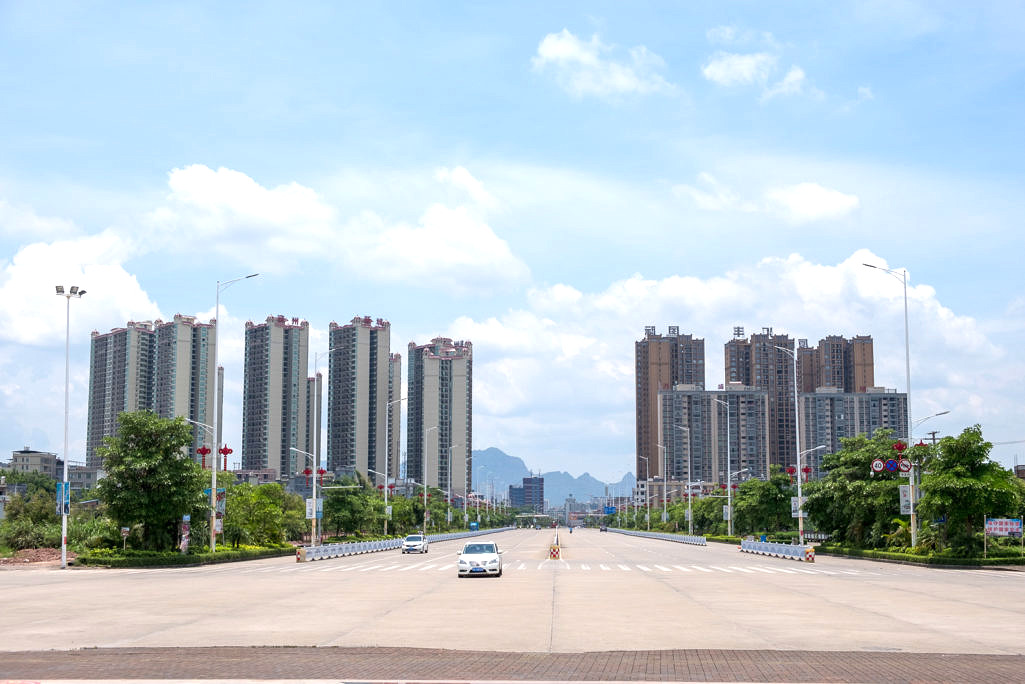
The bus continued on to the center of town to the Central Bus Station. Here I was even more astonished: there were two more tall towers under construction, their unmistakable forms riding out of the ancient scrum, covered in latticing and netting. Really? Here? In the middle of the old city?
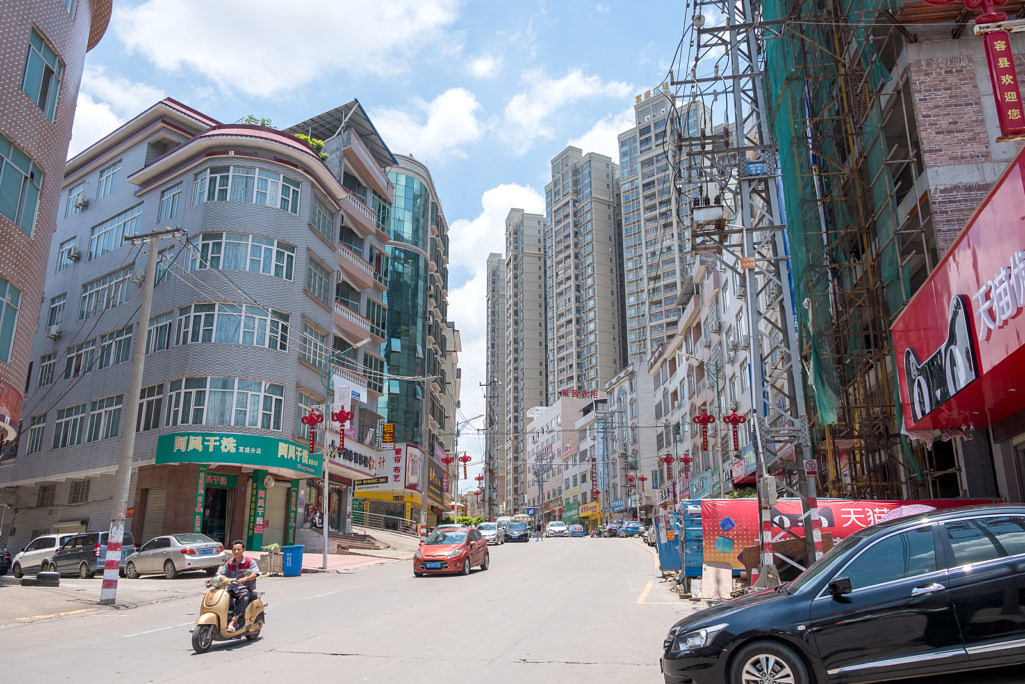
There was also a bar with a sign next to the bus station that boosted the availability of craft beer. Another surprise for me, as I never thought that Rongxian ever was a hotspot for fancy beers. (Though I have yet to go inside and find out if it really does have craft beer in the American sense, or if it’s simply “better and more expensive regular beer.”)
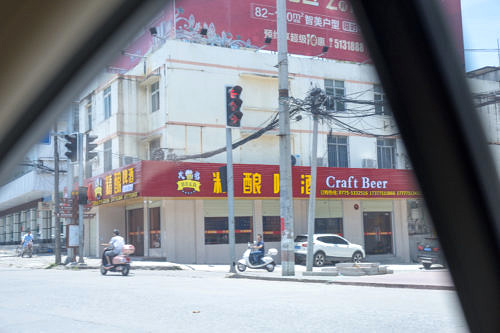
There to meet us was my uncle and my cousin. We loaded our bags into the trunk of his black Honda Accord and headed to my grandmother’s house on the north side of the river.
As we slowly crawled through traffic, my little brother Tony made an observation: the three-wheeled motorcycle-based taxis were in short supply on the roads. Instead, we had a lot more car taxis running around, mixed in with a lot more car traffic than I had remembered before.
Things really but home when we passed by the train station. Just a few years ago, I remembered walking down an empty six lane stretch of asphalt with a camera early in the morning, marveling at how a massive road was built from the city out to a train station that no one used. Despite being built for lots of traffic, I was free to walk wherever I pleased across the painted lines, as there was no one the road save for me and the occasional construction worker on a motorbike or working on the side of the road. On both sides of the road, nothing but dry earth, tinted with red clay. But now? On one side of the road, four tall apartment towers. On the other side, a mere three.
The province, the county, the city
Guangzhou (广州), situated in the Guangdong (广东) province, sits just north of Hongkong (香港) and Macau (澳门). I only remember coming back home to China once through Hongkong — the very first time when I was in second grade — and ever since then, we’ve always bussed our way to Rongxian from Guangzhou.
But for most people who aren’t familiar with China, if they ask where we are from, I’d say that we were from the Guangzhou region or the region surrounding Hongkong. If they are a little bit familiar with China, I’d say that we were from the Guangxi area.
The Guangxi (广西) province is on the western border of the Guangdong. To the west of the Guangxi is Vietnam, to give you an idea of just how far to the south and to the west home is.
On the eastern side of Guangxi is the city-level prefecture of Yulin (玉林). Within Yulin in the eastern half of the prefecture is Rongxian (容县), or Rong County as the literal translation goes.
Scattered about Rongxian are numerous little villages and towns. In the center of the county is a city, the administrative center of the entire county, officially named Rongzhouzhen. That is where the majority of my family lives, both on my mother and my father’s side. With few exceptions, those exceptions usually being my cousins leaving the small town life for something hopefully bigger and going off to cities like Nanning and Beijing, all of my grandparents and aunts and uncles are in the administration city.
I have always called this city “Rongxian,” though technically that name refers to the entire county. The entire county has about 700k people in it, and the city in the middle has… hmm, I’m not quite sure. I asked my cousin how many people were in the city, and he couldn’t really pin down a number anyway.
So while I can’t give you a figure, I can describe the city itself. Occupying the same geographical area as a small American town, Rongxian ratchets up the population density to a degree typically not found in small American towns in the middle of nowhere. For the folks who are familiar with Southeast Michigan, imagine a city about the size of Ypsilanti, surrounded on all sides by farms. Whereas Ypsilanti has about 20k people within its borders, the administration city of Rongxian, about the same size physically as Ypsilanti, has about 80k people or so — about 4x the population density of what you’d normally find in a small American city.
When I first started visiting Rongxian, back when I was just a kid in the 90’s, one could easily bike across town, and almost everybody rode motorcycles. If you had a car, you were hot stuff. My uncle had a Toyota Hilux quad cab pickup truck that he used for work, provided for him by the government, making our family one of the very few that access to four wheels and an enclosed cab. But the city was small, so getting around was very easy.
As the years passed, I watched the city grow and grow and grow. Not necessarily outward, mind you. Sure, there was some expansion of the city’s borders, but the thing I remembered most about the city was that it grew upwards. Most houses in the city of Rongxian were narrow but tall affairs; imagine the width of a 1.5 car garage and make it deep, then build four to five to even eight stories up — houses there look less like the houses here and more like narrow apartment buildings.
As things go more and more prosperous, the houses also started getting wider. Think “extra deep three car garage and build up on top.”
Whenever I traveled back to China, I’d catch a glimpse of the astonishing growth China has been experiencing, somewhat expected in the big metropolises of China, but perhaps not quite as expected out here, in the middle of nowhere. And yet, even nowhere is growing, and at a faster and faster clip than even I was expecting just a mere four years ago.
The traffic
What really blew my mind was just how many cars there were in the city now.
Tony quickly pointed out to me that the vast majority of the streets were now marked for curbside parking. This was something new that I didn’t remember seeing the last time I went to China, or at least, not to this extent.
There were so many marked parallel parking spaces that, in one case, a street outside my paternal grandparent’s house, once a busy makeshift marketplace with farmers and vendors laying out their wares on mats and in push carts, no longer had much in the way of street vendors anymore. In their place: parked cars. There were a couple of stubborn folks out there still hawking their produce and meats in the street in front of the parking spaces, one such person being my grandfather, but the energy definitely wasn’t the same as it was before.
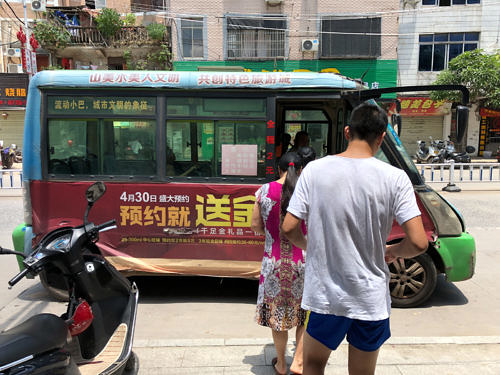
All of this parking appeared, naturally, because cars have appeared en masse in the city. Now, seemingly every single household had at least one car, even if it was perhaps a cheaper one, with many cars parked inside homes and many more parked outside on the streets. While cars have been increasing their numbers on the street, about half of the vehicular traffic is still motorbikes and scooters, with such vehicles now having the distinct advantage of being able to find parking almost anywhere.
I remember being blown away several years ago at the fact that the city had buses. They were tiny, little buses, no larger than a full size van here in the States, and only capable of carrying about a dozen passengers at a time, but they were buses nonetheless, roaming the streets in a city where buses previously weren’t really necessary. But now the city had grown, and walking across the city now took longer than it did before, and with the dramatic decrease in bicycles as a preferred mode of transportation, if you didn’t have a motorbike or a car, then a bus was your next best option.

This time around, not only where there little buses running around, but also big ones too. Okay, it’s probably best to qualify “big.” These buses woudln’t be big by American standards — the Rongxian buses are about half the length of your typical American city bus — but compared to the older, little buses, they were huge. I think these big buses could carry about three dozen people? I didn’t think a little city of Rongxian could need buses this big.
Also, as mentioned up above, Tony noted that a city that was once full of three-wheeler motorcycle taxis no had almost none. Replacing them were car taxis, and while I saw a few car taxis in previous visits, they were all cheap, miserable little cars that were barely a step up from the three-wheeler taxis they shared the road with. No longer — when hailing a taxi, you were far more likely to hail a Volkswagen rather than some cheap BYD.
That is, if you hailed a taxi. When we were in town and hanging out with our cousins, if we weren’t riding around in one of the family cars, we were using a ridesharing service instead. Here, it’s not Uber but Didi.
Back to the buildings
One of the first things we did once we got in town was go out and take a look at what had changed. Tony and I went out with my biaodi, Linfeng, and took a look at the new construction on the edge of town and the new construction in the center of town.
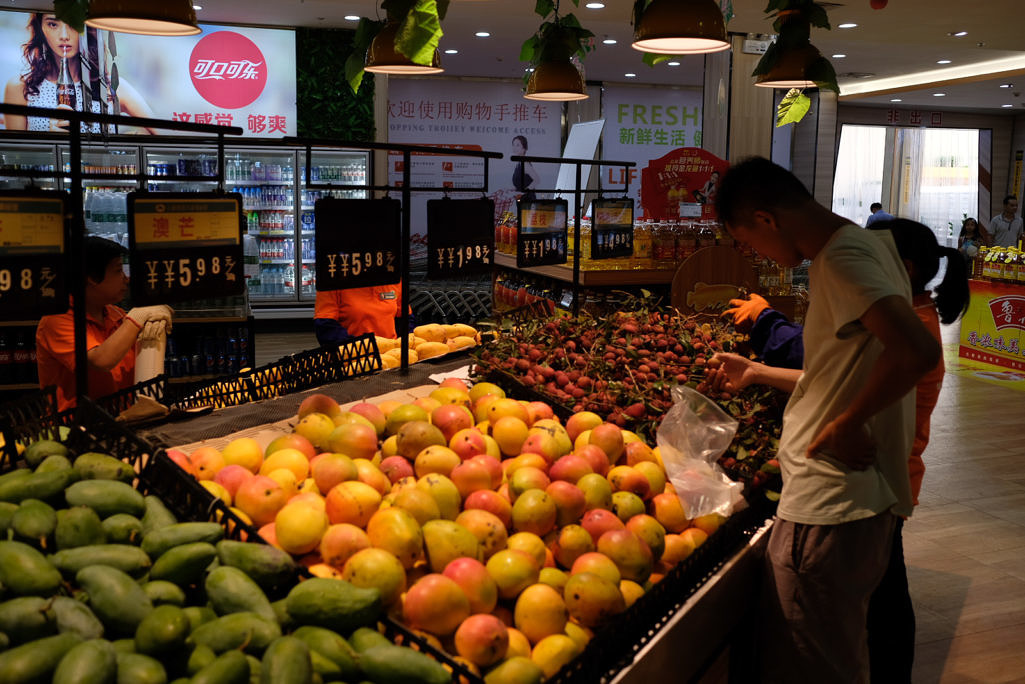
We first stopped by the tall apartment towers sitting on either side of the six lane avenue leading to the train station. At the base of one of the towers is a shopping mall that is being built out and slowly populated, an eerie mix of bustling activity in isolated parts of the mall and dead silence in the rest where stores haven’t been opened yet. We went down to the basement to take a look at one of the biggest supermarkets in the city, a brightly colored, very modern looking grocery store that could put a Whole Foods to shame in terms of both freshness of food and light, postmodern decor.

But of course, this being a podunk part of China, it had its weird Engrish charms.
The tour continued, and we went to the older part of town where small shops lined narrow streets and street vendors clogged what little space by the side of the road. I had been to this part of town every single time I’ve come back home to visit, and it’s been fascinating to see what has changed over the years and what hasn’t.
Some of the smaller boutique shops have been here for decades at this point. They instill a familiar sense of place, like the features of person’s face that may age but still retain the innate character that exists in a face from birth to death. But everything else around them have been slowly changing.

For example, one of the oldest and more interesting looking buildings along the shops is this apartment building with store fronts. It used to have much more character, with its slab grey exterior, darkened with black streaks from rainwater runoff that were probably never cleaned off from the day that it was built, making it look like the well-used pre-Communist era European-styled building I always associated with 19th century China.
Today, however, it looks… very different. Much in the same way that I’m not a fan of painting a vintage car a modern color, the exterior of the building has been redone in a sand colored veneer. It just looks… off to me. It took what I considered an honest looking but beautiful building and turned it into a brightly colored post-modern oddity to my eyes.
I don’t like the change, but I get why it would be done. You’re doing well, and this building looks super old. In modern China, you can’t have that. Old things with character aren’t really valued, so the mantra in China really is “out with the old, in with the new.”
Actually, maybe that face metaphor I mentioned above, which works now, won’t work in a decade or two. There’s always the possibility that the little shops close down and the retail mix changes (or even goes away entirely). I can’t be sure. You can generally recognize a face over time, but places can change so quickly that it’s entirely possible that I won’t recognize this part of town the next time I come by to visit.
I may be in for a big shock the next time I come back.
On the flip side of “making old things look weirdly new,” there’s the “build new things and make them look really old.” Out by the river bank is one of the city’s greatest treasures, an old tower that I’m sure was the tallest thing for miles around when it was first built centuries ago.

Architecturally, it’s a fascinating piece of work. The tower’s calling card is the fact that what looks like the primary support columns of the tower on each of the upper levels don’t actually reach the floor — they’re floating columns. “You can slip a piece of paper under the columns” is what they say. Furthermore, the entire tower uses no nails.
If you didn’t know that the support columns were floating, it’d probably look like any other old Chinese tower to you. I love that it looks like a regular tower, but if you look really closely, it isn’t. It’s my kind of quiet engineering absurdity — the we’ll-do-it-because-we-can.
Surround this tower is the remnants of a zoo, something hard for me to believe could exist in a place like Rongxian many years ago, but my parents have memories of visiting the zoo and playing there. For the longest time, this empty zoo was the only thing surrounding the old tower.
That has changed. In the time since I last visited, a whole new complex was built next door and opened up, making the entire area look like a miniature palace grounds. They made the existing open public space into something that looks like the square before a set of imperial age buildings, and built some sort of museum that houses who knows what — my cousins were adamant that there wasn’t anything interesting inside to look at, so we simply admired the buildings from the outside.

From a distance, the buildings do look impressive. Once you get up close, you can see that they’re all built from concrete, just like every other building in southern China these days. It is well formed, and mostly looks the part, but I can’t help but think that it would be way cooler and more authentic to go to the trouble of making at least parts of the building out of wood, particularly for the roof trusses, as the ends are exposed underneath the overhangs of the roof. When new, you probably couldn’t tell the difference between a wooden roof truss and a concrete form, but wood truss tips age in a graceful way whereas the concrete forms chip and crack.
It’s another post-modern interpretation of architecture from another time, done cheaply in concrete. Looks great right now as it’s all new and shiny — perhaps a bit too new and shiny, which gives the building sort of its own uncanny valley vibe — but I wonder how it’ll all look in about 20 years. I’m willing to bet good money that it won’t age nearly as gracefully as the ancient tower it sits next to, which wears its charm on its sleeve in the way only a building hundreds upon hundreds of years old can do.
Across the street from this museum complex is a row of houses. They used to look like the boring, square, Communist concrete block houses that they were, but have now transformed into an old imperial style look, also with the help of more concrete. I was told that the county fronted the money for these private homeowners to make the transformation. Once again, from a distance, it doesn’t look that bad, and I’m sure that the homeowners were more than willing to accept free home renovation money, but it looks a bit off to me.
Ultimately, it’s the same unease that I get when I see a late model, retro-styled Ford Thunderbird. It has a bunch of the right design cues, but it’s plastered over a modern car. I’m sure there are lots of people that like them, but I’m one that would prefer the earlier examples to the later tribute version.
The old/new dichotomy
Progress is good. Growth is good. Globalization is good. I’m definitely one who will bang on the drum of globalization and tout its benefits. It’s definitely helped Rongxian a lot.
At the root of of my mental unease with changes in Rongxian is the fact that I really don’t know what is driving the change. Part of it, I’m sure, was this flawed idea that Rongxian was nothing more than a quaint little county and city consisting primarily of little farmers, and would always be quaint and a little bit old-fashioned.
But I don’t understand what’s driving the current rate of growth. Is it a vastly improving agricultural industry? Is there another industry that’s driving growth that I’m not aware of? Is there simply money pouring into Rongxian from the likes of Nanning? (That’s my cousin’s pet theory, anyway.)
I also suppose that, as a lover of old things who actively works to rescue and preserve old things, I’m also in a bit of shock of how quickly the new is overwriting the old. It does make me wonder what will happen when the current “new” becomes tomorrow’s “old.” Probably the cycle will repeat, over and over until the end of time, as it has for literally centuries in one of the oldest civilizations of the history of mankind.